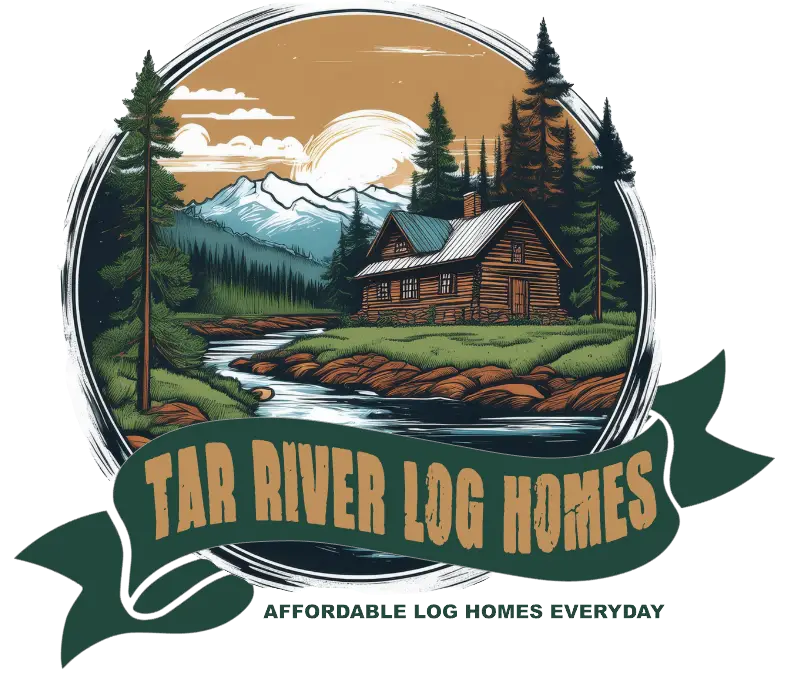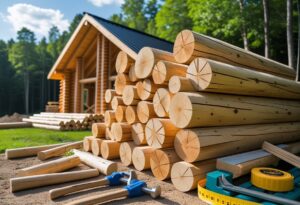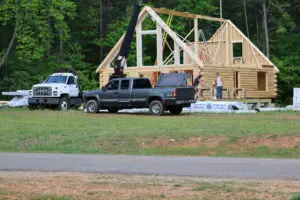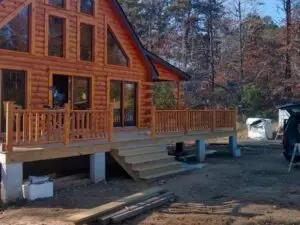Planning a log home is exciting, but it also comes with plenty of decisions. One of the most important steps is understanding what’s included in a log home kit. A clear log home kit materials list gives you confidence as you budget, prepare, and organize your build.
Tar River Log Homes makes this process simpler by providing transparent, detailed kits that help families save time and money. With clear documentation, you’ll know exactly what’s arriving at your site—from structural logs to fasteners and finishes—so you can avoid costly surprises.
In this article, we’ll walk through the typical contents of a log home kit, explore wood types and finishes, and review optional upgrades. By the end, you’ll understand what to expect in a materials list and how to choose the right kit for your needs.
Understanding Log Home Kit Materials
When you choose a log home kit, it’s important to know what kinds of wood are used, the quality of materials, and how the logs are prepared. These details affect your build’s durability, appearance, and ease of construction.
Types of Wood Used in Log Home Kits
Most log home kits use softwoods like pine, cedar, spruce, or fir. Pine and spruce are popular because they are widely available and affordable.
Cedar stands out for its natural resistance to decay and insects, making it a good choice if you want a low-maintenance exterior. The type of wood affects how your home handles moisture, temperature changes, and pests.
For example, cedar’s oils help it resist rot, while pine is easier to machine and more cost-effective. Select wood based on your climate and how much upkeep you want.
Grade and Sourcing of Materials
Wood grade tells you about the quality of the logs in your kit. Higher-grade logs have fewer knots, cracks, and imperfections, lending a cleaner look and better structural integrity.
Lower grades might be less expensive but could require more finishing work. Many kits use kiln-dried logs, which reduces moisture content to prevent future shrinking or warping.
Where your wood comes from matters, too. Logs sourced from local forests can match your climate better, while imported wood might be cheaper but less suited to your specific environment.
Pre-Cut vs. Milled Logs
Pre-cut logs come pre-shaped and numbered, ready to fit together like a puzzle. This cuts down on your building time and mistakes, but can cost more upfront.
Milled logs are shaped on-site or nearby and may require more skill and time to assemble. Pre-cut kits are popular for DIY builders or those wanting faster construction.
Milled logs give more flexibility in design but need experienced labor. Consider your budget and building experience when deciding between them.
Essential Components of a Log Home Kit
When you order a log home kit, you’ll receive materials that cover the key structural parts of your home. These are designed for easy assembly and weatherproofing.
Wall Logs
Wall logs form the backbone of your home’s structure. They come pre-cut, shaped, and often numbered to simplify assembly.
These logs are typically kiln-dried to reduce moisture, helping prevent future warping or shrinking. The logs are made to interlock tightly, creating strong, insulated walls.
Depending on your kit, you might get different profiles like round, square, or hand-peeled logs. Fasteners, sealants, and chinking materials are usually included to secure the logs and seal gaps.
Roof System Materials
Your roof system materials usually include pre-cut trusses, rafters, and sheathing, all tailored for your home’s design. Some kits provide a full roof package with metal or shingle roofing options, while others might leave roofing materials separate for you to source.
You’ll also typically get fasteners and sealants to ensure a tight fit and protection against the elements. The roof system is crucial for shielding your home from rain, snow, and wind. Completing the roof promptly helps maintain the integrity of your wall logs during construction.
Floor System Materials
Floor systems in log home kits include pre-cut joists, sub-floor panels, and decking materials. These parts form the foundation that supports your living space and connects the wall logs securely.
Quality floor materials help create a level, sturdy base for your home. Some kits may also include vapor barriers or insulation materials to improve energy efficiency. Like other components, these materials are often labeled and cut for easy placement.
Included Fasteners and Connectors
Your log home kit will come with the essential fasteners and connectors needed to hold the structure securely. These components are designed to fit your logs perfectly and provide reliable support at each joint and connection point.
Log Screws and Spikes
You’ll find that log screws and spikes are the primary fasteners used to join logs in your kit. Logs require long, heavy-duty screws or spikes because standard nails lack the holding power for thick, heavy timber.
These fasteners typically come made of galvanized or stainless steel to resist rust and corrosion. Their large diameter and length allow deep penetration, creating strong, stable connections between logs.
Some kits include specialized log screws with spiral threads that reduce splitting and pullout risks. Installing these screws or spikes properly is crucial—you’ll want to pre-drill to avoid cracking the wood, especially near log ends.
Metal Brackets
Metal brackets play a vital role in reinforcing corners, joints, and structural connections in your log home. They help stabilize areas where logs meet or where the structure carries extra loads, such as around windows, doors, and roof trusses.
Most kits include L-brackets, T-brackets, and angle brackets, all made from heavy-gauge steel or powder-coated materials to prevent rusting. These brackets come with pre-drilled holes so you can easily secure them using the screws provided.
Using brackets properly reduces movement and shifting over time caused by expansion, contraction, or settling of the logs.
Sealants and Gaskets
Sealants and gaskets are critical for keeping your log home weather-tight. Kits include specially formulated sealants and foam or rubber gaskets that fit between logs or around window and door frames.
The sealants are usually flexible, durable, and designed to fill gaps caused by log shrinkage or expansion. They help prevent air leaks and moisture intrusion, which protects your interior and increases energy efficiency.
Gaskets, often made from compressible foam, provide a tight seal by compressing between logs during assembly. Using the right combination of sealants and gaskets will keep your home cozy and protect the wood from environmental damage.
Doors, Windows, and Hardware
When building your log home, the right doors, windows, and hardware are essential for durability, energy efficiency, and style. You’ll find options ranging from pre-hung doors to specially designed window units, all paired with hardware that ensures smooth operation and security.
Pre-Hung Doors
Your kit often includes pre-hung doors, which come fully assembled with frames, hinges, and weather stripping. This setup makes installation quicker and ensures better alignment.
Common choices are Therma-Tru steel or fiberglass doors, which offer strength and good insulation. Interior doors usually come pre-hung as well, frequently in a 6-panel style, complete with hardware like Schlage locksets.
Window Units
Windows in your kit are typically high-quality Andersen® or similar brands known for energy efficiency and durability. Many kits include Low-E4 glass windows that reduce heat loss while letting natural light in.
Often featuring tilt-wash and casement styles for easy cleaning, colors and finishes vary, so you can select from sandtone, dark bronze, or white frames to best match your home’s design. Full screens come standard, allowing fresh air without pests.
Door and Window Hardware
Good hardware is key for both security and function. Expect handles, locks, hinges, and latches to be included, often from trusted brands like Schlage.
Entry doors might have keyed locks, while interior doors have privacy or passage hardware. Window hardware includes screens, locks, and easy-to-use cranks or tilt mechanisms.
Finishing and Protective Materials
When working on your log home, protecting the wood and enhancing its natural beauty are essential. This involves selecting materials that guard against weather, pests, and wear while adding warmth and character inside your home.
You’ll deal with surface treatments, sealing gaps, and interior finishes to complete your space.
Stains and Preservatives
You’ll want to use high-quality stains and preservatives designed specifically for log homes. These products protect your logs from UV damage, moisture, and insects.
Look for penetrating oil-based stains that soak into the wood rather than just coating the surface. These offer longer-lasting protection and reduce cracking or peeling.
Many stains also contain fungicides and mildewcides to prevent mold growth. When applying, ensure the logs are dry and free of dirt to maximize adhesion.
You should reapply these finishes every 3 to 5 years, depending on your local climate, to maintain the wood’s condition and appearance.
Chinking Supplies
Chinking fills the gaps between logs to seal your home against air and water infiltration. Modern chinking materials are flexible and durable, allowing for the natural movement of logs.
You’ll typically use synthetic chinking compounds made from acrylic or polyurethane. These bond well to logs and can expand and contract without cracking.
The application involves cleaning the gaps, removing old material, and then using a caulking gun to apply the chinking smoothly. You may also use backer rods in larger gaps to provide support.
Proper chinking reduces drafts, improves energy efficiency, and helps prevent pests from entering through cracks.
Interior Finishes
Inside, your focus will be on adding warmth and natural charm while protecting wood surfaces. Finished wood trims, ceilings, and walls benefit from clear varnishes, shellacs, or lacquers that enhance grain detail.
You might also choose interior stains or sealers to match or complement exterior stains. These products guard surfaces against moisture and everyday wear.
For interior doors, cabinetry, or built-ins, consider materials like V-match paneling or tongue-and-groove boards, which provide a clean, rustic look. Light finishes keep the wood feeling natural and fresh without darkening too much or masking the grain pattern.
Optional Kit Add-Ons and Upgrades
You can customize your log home kit by adding structural and functional elements that enhance your build. These options allow you to tailor your project to fit your lifestyle and specific needs.
Porches and Deck Kits
Porches and decks extend your living space outdoors and add visual appeal. These kits usually include pre-cut logs or siding, floor joists, decking boards, railings, and hardware.
You can often choose between different decking materials, such as tongue-and-groove pine or composite boards, depending on durability and maintenance preferences. Some kits also offer stairs and roof framing components to create covered porches.
Adding a porch or deck kit enhances your home’s usability for relaxing, dining, or entertaining. Make sure to check if the kit provides weatherproofing elements like flashing or sealants to protect the wood.
Garage and Outbuilding Materials
If you plan to build a garage or workshop alongside your log home, you can find compatible materials packages. These typically include wall logs, framing lumber, roof trusses, and subflooring that match your main home’s style and dimensions.
You may also have options for garage doors, insulated door kits, and windows designed for added security and energy efficiency. Some packages include optional items like concrete forms or foundation materials for a complete build.
We take pride in offering families comprehensive options to make cabin dreams a reality. With a carefully selected kit, you can build a beautiful, efficient home that fits your needs and budget.
Shipping, Packaging, and Handling Materials
When ordering a log home kit, understanding how your materials are shipped and packaged helps you plan for delivery and storage. Kits are usually bundled carefully to protect each component during transit.
Your logs, beams, and other large pieces are stacked on pallets or crated to avoid damage. Protective wrappings like plastic shrink wrap, tarps, or waterproof covers shield the wood from moisture and dirt.
Fasteners, sealing materials, and smaller items often come in labeled boxes for easy identification. Clear labeling helps you locate parts quickly when assembling your home.
Handling materials are included to secure loads during shipment. Straps, corner protectors, and cushioning materials prevent shifting and protect log edges.
Sometimes, packages arrive in multiple shipments depending on the kit size. It’s helpful to verify your delivery schedule and inspect items on arrival.
Below is a quick checklist of typical packaging materials you can expect:
| Material | Purpose |
| Pallets or crates | Support and organize heavy parts |
| Plastic wrap or tarp | Weather and moisture protection |
| Straps and ties | Secure loads for transport |
| Corner protectors | Prevent log edge damage |
| Labeled boxes | Organize small components |
Building With Confidence
A log home kit materials list is more than a checklist—it’s a roadmap to building your dream cabin. By knowing what’s included, you can prepare properly, avoid last-minute purchases, and streamline construction. Clarity upfront makes the process smoother and more affordable.
Tar River Log Homes is committed to helping families start with confidence. Our kits are designed with transparency in mind, ensuring you get the quality materials you need without hidden costs. With the right plan, building your log home becomes a rewarding and achievable goal.
Every detail, from fasteners to finishes, matters in creating a safe and lasting cabin. Start by reviewing your kit’s materials list closely, then plan your build step by step. With the right preparation, your cabin will provide comfort and character for years to come.
Explore detailed materials lists and discover how the right kit can simplify your log home build from start to finish.
Frequently Asked Questions
You’ll want to know exactly what your log home kit includes, what you can add or customize, and what extra materials you might need. Understanding costs, material quality, and any hidden fees will help you plan your project clearly.
What items are typically included in a log home kit?
A standard log home kit usually contains pre-cut logs, floor and roof framing, doors, windows, and fasteners. Some kits also include roofing materials, hardware, and building plans.
You will often see a detailed, line-item list with your kit, so you know what’s included upfront.
Can you customize the contents of a log home kit?
Yes, you can customize your kit. Choose different types of logs, add or remove components, and select options for finishes and features.
Customization helps fit the kit to your budget, climate, and design preferences.
What additional materials will I need beyond the log home kit for construction?
You will likely need foundation materials, insulation, interior finishes, plumbing, and electrical systems. Caulking and weatherproofing supplies are often necessary since logs can move and seals may break down over time.
Some tools and equipment for assembly may also be required if not provided.
What are the cost differences between log home kit options and traditional home building?
Log work often accounts for 25%-35% of the total cost of a finished log home. Kits can be more affordable upfront compared to custom building, but remember additional costs like labor and site preparation. Choosing different log types and finishes will influence overall expenses.
How do I determine the quality of materials in a log home kit?
Look for detailed specifications on logs, such as wood species, drying methods, and precision in milling. Reviews, warranties, and certifications can also help verify the quality.
Our focus is on providing only the best materials with transparency and value, helping families build their dream homes with confidence.
Are there any hidden costs associated with purchasing a log cabin kit?
Hidden costs may include delivery fees, foundation work, utility connections, permits, and additional finishes not included in the kit. Weatherproofing and maintenance materials should also be part of your budget. Tar River Log Homes encourages you to consider these factors when planning your project.




